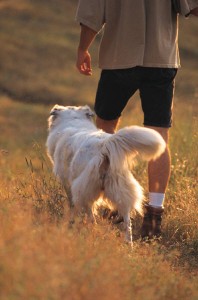
You may think that, as the writer, when you tell a story or write an article, you are leading your readers exactly where you want them to go. But is that really true?
Have you ever watched a dog out for a walk?
The person walks along in a straight line, glancing around a bit, but not deviating from the path. If there’s another person, they’ll be having a conversation, but very little attention is paid to the actual walk.
The dog, on the other hand, is busy. Sniffing around, veering off the sidewalk, looking for squirrels, and generally immersed in the Walk Experience. He doesn’t care that it’s almost the same walk as it was yesterday. The smells are still there for the sniffing. The sun is just as warm on his fur. He is out of the house and doing something fun, where anything can happen.
What does this have to do with writing?
Too often as writers, we get so wrapped up in trudging along the same old path, talking amongst ourselves, that we take for granted the wealth of possibilities around us. We come, we write, we get the job done, and then we move on.
But, to our readers, it’s all new. The stories and articles we write are filled with potential, like that moment in a movie theater when the lights dim and you are facing two hours of possible greatness. A reader opening a book, or clicking to a blog post, is ready and open to being entertained, or informed. Their eyes are open to possibilities.
It doesn’t matter if your mystery’s villain is predictable, or that your inspirational posts (cough) are trite. (Well, okay, it matters a little, but still.) You don’t expect to finish the latest John Grisham book feeling blown away with its originality. You’re reading John Grisham because he brings familiar things to his writing–his style, his vocabulary, his characters. The situations may be new, but the stories are familiar.
Just like walking around the block.
Your job as the writer? In this regard, it’s twofold.
First, provide the story. Just like your dog can’t enjoy his seemingly boring, every-day walk around the block on his own, you have to WRITE the story/post/article/essay for your readers to have someplace to go.
Second, let your readers bring themselves to the story. You might feel like the last thing the world needs is another romance novel, or how-to blog post, but every one offers the reader something they can’t get anywhere else–a chance to interact with you and your writing. For example, a scene you thought mundane might resonate because your reader had done something similar. Maybe a bit of throw-away dialogue might exactly mimic the fight they just had.
And, if your mundane writing efforts can resonate that way?
Think what your best work can do.
Talk about happily wagging tails.

Haha, I love this metaphor.
And also this is why some people prefer reading a story over watching a movie based on it – they get to use their imaginations and bring themselves to the story more in the case of reading.
.-= Kelvin Kao´s last blog ..New Taiwanese Puppet Series =-.
I am going to take this post to heart. Great analogy.
Maybe if I do my readers will stop following me around with plastic bags…
😉
George
.-= Tumblemoose´s last blog ..10 Outstanding Picture Writing Prompts =-.
Plastic bags, huh? I hadn’t really thought to address the QUALITY of the writing in just that way…
Pingback: Highlights from 2009